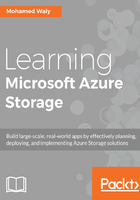
上QQ阅读APP看书,第一时间看更新
Blob storage
Blob stands for binary large object. This type of service can store almost everything since it stores unstructured data, such as documents, files, images, VHDs, and so on.
Using the Azure Blob storage service makes you capable of storing everything we have just mentioned, and able to access them from anywhere using different access methods, such as URLs, REST APIs, or even one of the Azure SDK Storage Client Libraries, which will be covered later in this chapter.
There are three types of Blob storage:
- Block blobs: They are an excellent choice to store media files, documents, backups, and so on. They are good for files that are read from A-Z (sequential reading).
- Page blobs: They support random access for files stored on them, that is why, they are commonly used for storing VHDs of Azure Virtual Machines.
- Append blobs: They are similar to block blobs, but are commonly used for append operations. For example, each time a new block is created, it will be added to the end of the blob. One of the most common use cases within which append blobs can be used is logging, where you have multiple threads that need to be written to the same blob. This is an excellent solution that would help you to dump the logs in a fast and safe way.